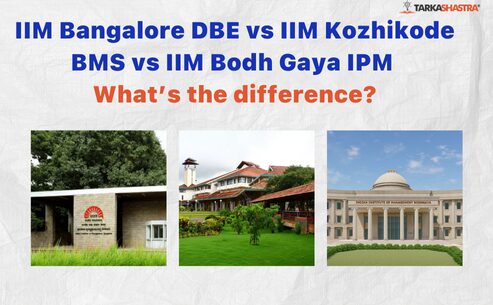The Integrated Program in Management Aptitude Test (IPMAT) conducted by IIM Indore and IIM Rohtak is one of the most competitive entrance exams for students aspiring to secure a place in the prestigious 5-Year Integrated Program in Management (IPM). Among all the sections of IPMAT, the Quantitative Aptitude (QA) section is often regarded as the toughest yet the most scoring.
Over the years, a clear pattern has emerged — questions from Arithmetic, Algebra, and Data Interpretation (DI) consistently carry the highest weightage in the Quantitative section. These areas form the backbone of IPMAT’s math syllabus and determine whether a candidate clears the sectional and overall cut-offs.
Why is this important? Focusing on these high-yield topics ensures efficient preparation. Instead of spreading time thin across every topic, smart aspirants prioritize Arithmetic basics, Algebra problem-solving, and accuracy in DI sets, giving them a clear edge over competitors.
To give you a quick snapshot, here’s how Arithmetic, Algebra, and DI dominate the IPMAT Quant section:
| Quantitative Area | Weightage in IPMAT | Difficulty Level | Importance |
| Arithmetic | 35–40% | Easy to Moderate | Foundation for most word problems & DI |
| Algebra | 25–30% | Moderate to High | Tests logical application & formulas |
| Data Interpretation (DI) | 15–20% | Moderate | Accuracy-focused, scoring with practice |
In this blog, we’ll break down these high-weightage areas, analyse their trends, and give you actionable strategies to maximise your score in IPMAT 2026 and beyond.
Overview of IPMAT Quantitative Aptitude Section
The Quantitative Aptitude (QA) section is the most decisive part of IPMAT. While both IIM Indore and IIM Rohtak conduct their own versions of the exam, the quantitative section structure is slightly different in format and marking. Yet, the underlying theme remains the same — candidates are tested on a mix of Arithmetic, Algebra, Data Interpretation, Geometry, and higher mathematics.
Key Features of QA in IPMAT
- Conceptual depth: Questions go beyond Class 10 basics and require logical application.
- Various formats: IIM Indore includes Short Answer (SA) questions without options, while Rohtak sticks to MCQs.
- Time pressure: With sectional time limits, accuracy and speed are equally important.
- Weightage: QA is often the highest-weight section, forming nearly 50% of the total score in some years.
IPMAT Indore vs IPMAT Rohtak – Quantitative Aptitude Structure
| Exam | Question Format | No. of Questions (Approx.) | Time Limit | Negative Marking | Special Feature |
| IPMAT Indore | MCQs + Short Answer (SA) | 30 MCQs + 15 SA | 40 + 40 min QA | Yes (-1 for MCQ), No negative for SA | SA tests conceptual clarity |
| IPMAT Rohtak | Only MCQs | 40 MCQs | 40 min QA | Yes (-1 for each wrong answer) | More speed-driven section |
Insight:
- Indore: A strong Algebra & higher-math foundation is crucial, as SA questions are often algebra-heavy.
- Rohtak: Arithmetic & DI-based word problems dominate, making it relatively more approachable but time-intensive.
Thus, while the topic coverage overlaps, preparation must be slightly tuned depending on whether a student is aiming for Indore, Rohtak, or both.
High-Weightage Quantitative Topics – At a Glance
While IPMAT Indore and IPMAT Rohtak differ slightly in structure, the Quantitative Aptitude (QA) section in both exams revolves around a standard set of high-yield topics. A detailed look at past papers and official syllabi reveals that Arithmetic, Algebra, and Data Interpretation (DI) consistently carry the maximum weightage.
- Arithmetic dominates with questions on percentages, ratios, averages, time–speed–distance, and work problems.
- Algebra contributes heavily, especially in Indore’s Short Answer section, with functions, equations, inequalities, and sequences frequently appearing.
- Though smaller in proportion, Data Interpretation (DI) is a scoring zone as it blends Arithmetic with logical reasoning (tables, graphs, charts).
Here’s a consolidated snapshot of topic weightage across Indore & Rohtak:
| Quantitative Area | Approx. Weightage | Typical Topics Asked | Difficulty Level | Why It Matters |
| Arithmetic | 35–40% (Indore & Rohtak) | Percentages, Profit & Loss, Ratio & Proportion, Averages, Time & Work, Speed–Distance | Easy to Moderate | Forms the backbone of QA; appears directly & in DI sets |
| Algebra | 25–30% (higher in Indore SA) | Linear & Quadratic Equations, Inequalities, Functions, Sequences & Series, Logarithms | Moderate to High | Tests higher-order logic; crucial in Indore’s Short Answer |
| Data Interpretation (DI) | 15–20% | Tables, Bar Graphs, Pie Charts, Caselets | Moderate | Accuracy-driven; strong area for scoring quickly |
| Other Topics | 15–20% | Geometry, P&C, Probability, Set Theory, Coordinate Geometry | Moderate | Secondary weight; cannot be ignored but less frequent |
Key Insight:
- At IIM Indore, Algebra and advanced math (logs, functions, sequences) feature more prominently in the Short Answer (SA) section.
- At IIM Rohtak, Arithmetic and DI lead, with direct application-based questions forming the bulk of QA.
For thoughtful preparation, target 70% of your QA practice time on Arithmetic, Algebra, and DI. Use the remaining 30% for Geometry, Probability, and other secondary topics.
Arithmetic: The Backbone of IPMAT Quant
If there’s one area in the IPMAT Quantitative Aptitude section that every aspirant must master, it’s Arithmetic. Across IPMAT Indore and Rohtak, Arithmetic consistently forms the most significant chunk of questions (35–40%). The reason is simple — Arithmetic concepts are tested directly and serve as the foundation for word problems, DI sets, and application-based questions.
1. Key High-Weightage Topics in Arithmetic
From past year papers and official syllabi, the following topics appear most frequently:
| Subtopic | Concepts Tested | Approx. Weightage |
| Percentages & Profit–Loss | Successive % changes, mark-ups, discounts, profit margins | 3–4 Qs |
| Ratios, Proportion & Mixtures | Direct/Inverse proportion, alligation, weighted averages | 3–4 Qs |
| Averages & Ages | Weighted averages, group averages, age-based word problems | 2–3 Qs |
| Time, Speed & Distance | Relative speed, trains, boats & streams, races | 2–3 Qs |
| Time & Work | Work efficiency, pipes & cisterns, combined work problems | 2–3 Qs |
| Simple & Compound Interest | Growth/decay, installment-based problems | 1–2 Qs |
| Basic Number Applications | HCF-LCM, unitary method, ratios in real-life scenarios | 1–2 Qs |
- IPMAT Indore: Arithmetic MCQs usually cover profit–loss, ratios, SI/CI, and speed–distance.
- IPMAT Rohtak: More direct application problems (SI/CI, percentages, boats & streams, mixtures).
2. Why Arithmetic is Crucial
- Largest share in QA: Nearly 40% of quant questions are rooted in Arithmetic.
- Direct & Indirect role: Concepts like ratios, averages, and percentages often reappear in Data Interpretation sets.
- Scoring with practice: Once formulas and shortcuts are mastered, these questions can be solved in under 1 minute each.
- Bridges basics & advanced math: Strong Arithmetic helps confidently approach Algebra and higher-level topics.
3. Strategy to Master Arithmetic for IPMAT
- Start with NCERTs (Class 9–10): Clarify percentages, ratios, and SI/CI before proceeding to shortcuts.
- Learn calculation hacks: Techniques for successive percentage changes, ratio-based solving, and LCM/HCF-based work problems save time.
- Daily drills: Dedicate 30 minutes daily to speed-based Arithmetic practice.
- DI Integration: Practice DI sets (tables/graphs) that combine percentages and averages.
- Past Year Analysis: Revise recurring question types, such as profit-markup problems, pipes and cisterns, and boat-speed questions.
Pro Tip:
In Rohtak, time-intensive word problems make speed a deciding factor. In Indore, conceptual clarity matters more, especially when Arithmetic blends with Algebra in tricky SA-type questions.
Algebra: The Scoring but Tricky Section
If Arithmetic is the backbone of IPMAT Quant, then Algebra is its real test of depth and logic. Algebra consistently contributes 25–30% of the questions, with a higher emphasis in IPMAT Indore’s Short Answer (SA) section. Unlike Arithmetic, which relies more on formula application, Algebra demands conceptual clarity, pattern recognition, and precise calculations.
1. Key High-Weightage Topics in Algebra
From past year papers and official syllabi, the following topics appear most frequently:
| Subtopic | Concepts Tested | Approx. Weightage |
| Linear & Quadratic Equations | Solving equations, word problems, roots & discriminants | 3–4 Qs |
| Inequalities (Linear/Quadratic/Modulus) | Range-based problems, graphical interpretations | 2–3 Qs |
| Functions & Graphs | Domain & range, composite functions, piecewise functions | 2–3 Qs |
| Sequences & Series | AP, GP, HP, sum of n terms, special series (squares/cubes) | 2–3 Qs |
| Polynomials & Factorization | Remainder theorem, algebraic identities, higher-degree simplifications | 1–2 Qs |
| Logarithms & Indices | Laws of logs, simplification, exponents & surds | 1–2 Qs |
- IPMAT Indore: Algebra-heavy, especially in the SA section (logs, functions, inequalities, series).
- IPMAT Rohtak: Algebra appears mainly in MCQs, usually linear/quadratic equations and inequalities.
2. Why Algebra is Important
- High difficulty = high differentiator: Few students master it, so strong Algebra can set you apart.
- SA section focus (Indore): With no negative marking, Algebra questions in SA give you a golden chance to score if you know the method.
- Crossover with advanced math: Functions, inequalities, and sequences overlap with topics like coordinate geometry and probability.
3. Strategy to Master Algebra for IPMAT
- Concept-first approach: Don’t just memorise formulas — practice derivations to understand why they work.
- Graphical understanding: For inequalities and functions, learn to solve with number-line and graph methods.
- Target SA practice (Indore): Dedicate weekly practice to writing solutions without MCQ options.
- Error-free calculations: Double-check algebraic simplifications, as one small sign mistake can cost the entire answer.
- Mix with Arithmetic: Many Algebra questions (e.g., mixture, work problems) use linear equations in disguise.
Pro Tip:
- In Indore, prioritise Algebra in SA since topics like functions, logs, and sequences dominate.
- In Rohtak, Algebra is slightly less intense, but ignoring quadratic equations or inequalities can still cost 5–6 marks.
Data Interpretation: Application of Arithmetic + Logic
Unlike Arithmetic and Algebra, Data Interpretation (DI) doesn’t test you on pure formulas. Instead, it checks how quickly and accurately you can analyse numerical data. While DI contributes a smaller share (around 15–20%), it’s a high-scoring zone because the underlying concepts often come from basic Arithmetic.
1. Common DI Sets in IPMAT
From past year analysis and syllabus references, the most recurring DI formats include:
| DI Format | Typical Skills Required | Appearance in Exam |
| Tables | Percentage changes, averages, ratios | Frequent in Indore & Rohtak |
| Bar Graphs & Line Graphs | Trend comparison, slope analysis | Moderate |
| Pie Charts | Fraction-to-percentage conversion | Moderate |
| Caselets (Paragraph DI) | Data extraction & calculation-heavy | Often in Indore |
| Mixed DI | Combination of tables + graphs | Occasional |
- IPMAT Indore: Usually includes one complete DI set (5 questions) in the MCQ section.
- PMAT Rohtak: DI appears in 3–4 sets, often requiring quick calculations involving ratios, percentages, or averages.
2. Why DI is High-Value
- Accuracy-focused: No complex theory — just calculation + interpretation.
- Low preparation time: Once you master Arithmetic basics, DI becomes a direct application.
- Time management: A well-practised DI set can fetch 16–20 marks in one go.
3. Strategy to Master DI for IPMAT
- Revise core Arithmetic: Percentages, ratios, and averages form the backbone of DI.
- Practice with a stopwatch: Train yourself to solve each DI set within 6–7 minutes.
- Use approximation smartly: Especially in pie charts and bar graphs, where exact values aren’t always necessary.
- Build endurance: Practice solving back-to-back DI sets under mock exam conditions.
- Prioritise accuracy: A single mistake in calculation can affect multiple linked questions.
Pro Tip:
- For Indore, focus on 1 complete DI set (5 Qs) and aim for 100% accuracy.
- For Rohtak, get comfortable with multiple DI formats, as 4–5 questions regularly appear from DI.
Topic-Wise Weightage Trend (Past Year Papers)
One of the smartest ways to prepare for the IPMAT is to study past-year trends. While the exact question distribution may vary every year, a consistent pattern has emerged: Arithmetic, Algebra, and DI together form nearly 70–80% of the QA section across Indore and Rohtak.
Here’s a consolidated view of how the three high-weightage areas have performed in recent years:
IPMAT Indore – Quantitative Aptitude Trends (MCQ + SA)
| Year | Arithmetic (%) | Algebra (%) | DI (%) | Other Topics (Geometry, P&C, Probability, etc.) |
| 2023 | 38% | 32% | 15% | 15% |
| 2024 | 40% | 30% | 15% | 15% |
| 2025 | 37% | 31% | 17% | 15% |
Observation: Indore consistently tests Algebra-heavy concepts in the Short Answer (SA) section, while Arithmetic dominates the MCQs.
IPMAT Rohtak – Quantitative Ability Trends
| Year | Arithmetic (%) | Algebra (%) | DI (%) | Other Topics |
| 2023 | 42% | 22% | 18% | 18% |
| 2024 | 39% | 24% | 20% | 17% |
| 2025 | 41% | 23% | 19% | 17% |
Observation: Rohtak leans more on Arithmetic and DI, making it slightly more approachable than Indore, but calculation speed becomes the differentiator.
Key Insights from Trends
- Indore: Algebra is unavoidable; thoroughly prepare functions, logs, and inequalities.
- Rohtak: DI + Arithmetic dominate, so time efficiency in solving application-based word problems is critical.
- Across both exams, mastering these three pillars (Arithmetic, Algebra, DI) almost guarantees clearing the QA cut-off.
Preparation Roadmap for IPMAT Quant (2026 Focus)
Cracking the Quantitative Aptitude section of IPMAT isn’t just about solving hundreds of questions — it’s about preparing smartly with a roadmap that balances concept-building, practice, and time management. With the exam just months away, here’s a step-by-step prep plan for IPMAT 2026 aspirants.
1. Phase 1 – Build Strong Foundations (Months 1–2)
- Cover NCERTs (Class 9–11): Strengthen basics in Arithmetic & Algebra.
- Formula Sheet: Maintain a notebook with all key formulas (percentages, ratios, sequences, functions).
- Daily Practice (60–90 mins):
- 10 Arithmetic questions
- 10 Algebra questions
- One small DI set
- Goal: Accuracy > Speed in this phase.
2. Phase 2 – Topic-Wise Mastery & Speed Building (Months 3–4)
- Arithmetic: Focus on Time-Speed-Distance, Time & Work, Mixtures, SI/CI.
- Algebra: Deep dive into Quadratics, Inequalities, Functions, Sequences & Series.
- DI Practice: Attempt one DI set daily under 10 minutes.
- Mock Tests: Begin with sectional mocks (40 minutes for QA).
- Goal: Build consistency and identify weak areas.
3. Phase 3 – Integrated Practice & Exam Simulation (Months 5–6)
- Mixed Sets: Practice mock papers combining Arithmetic, Algebra & DI.
- SA Practice (Indore Focus): Attempt 10 Short-answer questions weekly, using step-by-step solving.
- Rohtak Strategy: Drill speed-based word problems + multiple DI sets.
- Weekly Mocks: 2 full-length mocks + analysis.
- Goal: Improve decision-making on which questions to attempt/skip.
4. Final 6 Weeks – Revision & Exam-Mode Prep
- Formula Recap: Daily 15-min formula + shortcuts revision.
- Error Log: Revise mistakes from past mocks to avoid repetition.
- Timed DI Sets: Practice solving 3 DI sets back-to-back within 20 minutes.
- High-Weightage Topics Focus: Revise Arithmetic (percentages, ratios, TSD, work) + Algebra (functions, sequences, logs) thoroughly.
- Goal: Push accuracy above 80% while maintaining speed.
Smart Resource Allocation
- Books:
- NCERT Maths (Class 9–11) – foundation building
- Quantitative Aptitude for CAT by Arun Sharma – advanced practice
- Mocks & Sectionals: Use IPMAT-specific mocks (Tarkashastra, CL, IMS, TopRankers).
- Self-Tracking Tool: Maintain a progress tracker (✅ Done, ⚠ In Progress, ❌ Yet to Start).
Pro Tip: Treat Indore as “JEE-Light” (with focus on Algebra & higher math) and Rohtak as “CAT-Light” (speed & accuracy in Arithmetic + DI). Preparing with this mindset ensures you’re well-balanced for both exams.
Common Mistakes to Avoid
Even the most hardworking IPMAT aspirants lose valuable marks in Quant not because of a lack of knowledge, but because of avoidable mistakes. Understanding these pitfalls early will help you prepare smarter and avoid repeating common errors.
1. Ignoring the Basics of Arithmetic
- Many students assume Arithmetic is “too easy” and skip thorough revision.
- Why it hurts: IPMAT Rohtak especially has multiple application-based Arithmetic questions (SI/CI, TSD, Ratios) — careless mistakes here cost 15–20 marks.
- Fix: Revise NCERT-level concepts regularly and practice calculation-intensive word problems.
2. Over-Focusing on Advanced Algebra Without Mastery of Fundamentals
- Aspirants often jump into functions, inequalities, and logs without mastering linear/quadratic equations.
- Why it hurts: IPMAT Indore’s Short Answer section heavily tests conceptual depth; weak fundamentals lead to silly mistakes.
- Fix: Solidify basics (identities, factorisation, equations) before tackling advanced topics.
3. Neglecting DI Practice
- Some students treat DI as “just Arithmetic,” ignoring timed practice.
- Why it hurts: DI requires accuracy + speed under pressure. Even small calculation slips affect multiple linked questions.
- Fix: Solve at least 2 DI sets daily with a stopwatch.
4. Poor Time Management During Sectional Tests
- Spending too much time on tricky Algebra questions leaves little time for easy Arithmetic/DI ones.
- Why it hurts: Indore & Rohtak have strict sectional time limits — you cannot recover lost minutes.
- Fix: Follow a “2-pass strategy” — attempt sure-shot questions first, mark tougher ones for later.
5. Not Reviewing Mock Tests Properly
- Many aspirants attempt mocks but skip error analysis.
- Why it hurts: Repeating the same mistakes lowers accuracy, reducing percentile improvement.
- Fix: Spend at least 1.5x mock duration reviewing errors, identifying weak topics, and updating an error log.
6. Over-Reliance on Shortcuts
- Shortcut tricks are useful but dangerous when applied blindly.
- Why it hurts: IPMAT SA questions (Indore) demand complete conceptual solving — guesswork won’t help.
- Fix: Use shortcuts for speed, but ensure you can solve step-by-step if required.
Key Takeaway:
IPMAT is not about solving every question — it’s about solving the right questions accurately within the time limit. Avoid these common mistakes, and you’re already ahead of most test-takers.
Conclusion
The Quantitative Aptitude section of IPMAT can feel overwhelming. Still, if you carefully observe past trends, the secret is simple: focus on Arithmetic, Algebra, and Data Interpretation (DI). These three areas account for 70–80% of the quant paper, making them the real game-changers.
- Arithmetic gives you speed and confidence.
- Algebra tests your depth and logical clarity.
- DI rewards accuracy and quick interpretation.
If you build strong fundamentals, practice regularly under time limits, and avoid the common mistakes we discussed, you can turn Quant from a roadblock into your strongest scoring section.
At Tarkashastra, we specialise in guiding aspirants through a structured approach — from concept clarity to mock analysis. Our expert mentors for IPMAT Indore and Rohtak ensure you know exactly where to focus and how to maximise your marks.
Remember: In IPMAT, success doesn’t come from solving all questions — it comes from solving the right ones, smartly and accurately.
Ready to master high-weightage Quant topics and secure your IIM IPM seat? Join Tarkashastra’s IPMAT coaching today — where strategy meets success.
FAQs on High-Weightage Quantitative Topics for IPMAT
1. Which quantitative topics carry the highest weight in IPMAT?
The topics with the highest weight in IPMAT are Arithmetic, Algebra, and Data Interpretation (DI). Together, they make up almost 70–80% of the Quant section, making them the most crucial for preparation.
2. How many questions in IPMAT are from Arithmetic?
Generally, 35–40% of the QA section comes from Arithmetic. Topics like percentages, ratios, time–speed–distance, and averages are tested almost yearly in Indore and Rohtak exams.
3. Is algebra more important in IPMAT Indore than Rohtak?
Yes. Algebra is heavier in Indore, especially in the Short Answer section (functions, inequalities, sequences, logs). Algebra appears in Rohtak but with slightly less emphasis than Arithmetic and DI.
4. How many DI questions can I expect in IPMAT?
In Indore, the MCQ section usually includes one full DI set (5 questions). In Rohtak, 3–4 sets appear, contributing around 15–20% of the Quant section.
5. Why is Arithmetic called the backbone of IPMAT Quant?
Because Arithmetic alone contributes around 40% of the paper. It appears directly and supports word problems and DI sets, making it the most foundational part of preparation.
6. Are there Geometry questions in IPMAT?
Yes, but they carry less weightage (5–10%) than Arithmetic or Algebra. Questions on triangles, circles, measurement, and coordinate geometry may appear but are secondary in importance.
7. Is the Quant section of IPMAT more challenging than other BBA exams?
Yes. IPMAT (especially Indore) includes Class 11–12 level math like functions, logs, and inequalities, unlike NPAT or SET, which focus mainly on Class 10 concepts. This makes IPMAT Quant more challenging but also more scoring with preparation.
8. Do I need to study Class 12 Math for the IPMAT?
For Indore, yes — especially for Algebra topics like sequences, functions, logs, and inequalities. For Rohtak, the focus is mostly on Class 9–11 level Arithmetic and Algebra.
9. Which is easier: IPMAT Indore Quant or Rohtak Quant?
Generally, Rohtak’s Quant is considered more approachable since it emphasises Arithmetic and DI. Indore’s Quant is tougher because its Short Answer section tests higher-order Algebra without options.
10. How should I start preparing for Arithmetic in IPMAT?
Begin with NCERT Class 9–10 basics (percentages, ratios, averages). Once concepts are clear, move to speed-building with practice sets. Daily problem-solving for 30–40 minutes on Arithmetic will steadily improve accuracy.
11. Which Algebra topics should I prioritise for IPMAT?
Focus on linear & quadratic equations, functions, inequalities, sequences & series, and logarithms. These are repeated year after year and form a significant part of Indore’s Short Answer section.
12. Is Data Interpretation difficult in IPMAT?
No, DI is relatively straightforward. It’s based on Arithmetic basics like percentages, ratios, and averages. The challenge is time management since calculations can be lengthy.
13. Can I skip Probability and Permutation–Combination?
While these are not high-weightage topics, they usually contribute 1–2 questions each. Skipping them entirely is risky; learn the basics to attempt easier ones.
14. Is there negative marking in Quant?
Yes, in both exams: -1 for wrong answers in MCQs. However, Indore’s Short Answer (SA) section has no negative marking, making it a strategic scoring opportunity.
15. How can I improve speed for DI in IPMAT?
Practice approximation techniques, percentage conversions, and ratio-based calculations. Solving 2–3 DI sets daily with a timer will build the required speed and accuracy.
16. Are calculators allowed in IPMAT Quant?
No, calculators are strictly not allowed. All calculations must be done manually, so improving mental math and calculation speed is essential.
17. Which books are best for IPMAT Quant preparation?
Recommended resources include NCERT Maths (Class 9–11), Quantitative Aptitude for CAT by Arun Sharma, and IPMAT-specific practice material from coaching institutes like Tarkashastra, IMS, and Career Launcher.
18. How many mocks should I take for the IPMAT Quant?
Ideally, 12–15 full-length mocks and 20–25 sectional tests for Quant. Reviewing mistakes after every mock is more critical than the number of attempts.
19. What is the difference between Arithmetic and DI preparation?
Arithmetic requires concept clarity and formula application, while DI requires speed in applying Arithmetic to interpret data. Practising both in parallel ensures balance.
20. Which topics should I focus on if I start late?
Prioritise percentages, ratios, averages, time–speed–distance, quadratic equations, and DI. These cover most high-weightage areas and give maximum return on effort.
21. Is Algebra scoring in IPMAT?
Yes, though tricky, algebra is perfect if concepts are clear. Since many aspirants struggle with it, mastering Algebra gives you an exceptionally competitive edge in Indore.
22. Do cut-offs reflect topic-wise weightage in Quant?
Indirectly, yes. Since Arithmetic, Algebra, and DI dominate the section, clearing the cut-off is nearly impossible without being strong in these three areas.
23. How much daily time should I spend on Quant preparation?
Ideally, 2–3 hours per day, split into:
- 1 hour Arithmetic
- 1 hour Algebra
- 30–45 mins DI practice
- This ensures balanced coverage of all high-weightage areas.
24. Can strong Quant skills cover up for weaker Verbal in IPMAT?
Not completely, since both sections have separate cut-offs. However, excelling in Quant (especially high-weight topics) ensures you clear the most challenging part, giving you more room to manage Verbal.
25. How does Tarkashastra help with IPMAT Quant preparation?
At Tarkashastra, students receive sectional workshops on Arithmetic, Algebra, and DI, customised mocks, and mentor-led error analysis. This targeted guidance ensures that aspirants focus on high-weightage topics and avoid wasting time on low-priority areas.







